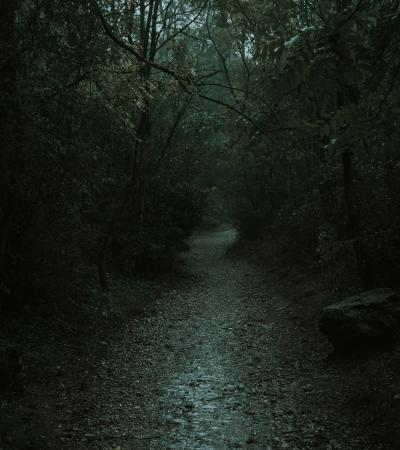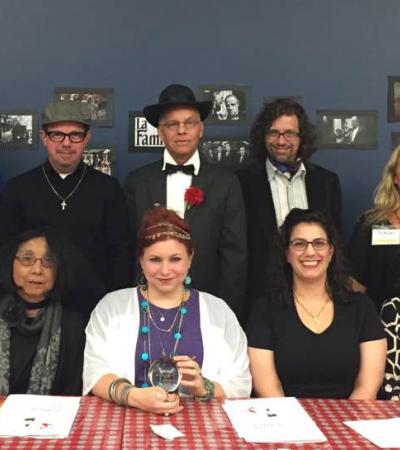Mystery events are a fun and creative way to highlight library spaces and resources, as well as create interesting and memorable experiences for users.
While you can always invest in pre-made “Mystery in a Box” games or hunt down online kits, there is great enjoyment in designing your own custom mystery, for both the participants and the design team. It also allows you to incorporate the use of library resources and spaces in an educational and informative way (all under the guise of mystery-filled fun).
Last spring, the Columbia College Chicago (CCC) Library hosted a Murder Mystery ‘80s Horror Prom that involved a deceased prom queen, period costumes and a slew of ‘80s music and prom décor.
In 2016, we added The Bundt Cake Bump-Off, a baking–themed mystery game, to our annual Edible Books & Tea event. Both games were conceived, created and executed by the library's Gaming Society, and they garnered great feedback from participants.
Advanced Planning
Things to think about in planning:
- What is your theme/premise? The possibilities are endless: pop culture, decades of history, film genres, etc. Is it a murder to be solved or could it also be a bank robbery, art heist or stolen library book?
- What are your resources, both financial and time? Much can be accomplished with a small budget. However, in the absence of funds, a little time can work a whole lot of wonders. Use staff expertise to create decorations and props. Host the mystery as a potluck or serve something simple, like cookies and coffee. Remember, the more intricate your mystery, the more time in creating and playing it, so adjust according to your needs and abilities (as well as potential attendees’ attention spans).
- What kind of mystery is it? There are several different formats for mystery games, so decide which best suits your needs. (See a list of mystery game formats under Attachments at right.)
- Individual vs. teams? If teams, how large a team is ideal? Is the nature of the mystery easily solved on an individual level, or would it be better if collaboration were possible?
- What sort of tech support and connectivity will be necessary? Consider your space. Are the mystery and the clues limited to a single area or are they spread throughout a larger space? Is the roaming area large or small? Does it involve physical or electronic clues (catalog searches, social media hints, etc.).
Creating Your Mystery
- Create a storyline/plotline. Ask yourself:
- Has the murder already occurred?
- Where is your setting? A library or somewhere else?
- Who are your players/characters? Can you write a simple list or paragraph of their detail — what they look like, their temperament, other details and motives?
- What is the timeline of your murder/crime/mysterious occurrence? This will help you create alibis for your characters that will narrow your suspects.
- Work backwards. If you’ve determined that character X perpetrated your art heist, then begin by creating alibis for other characters. The more your other characters have a possible motive for committing the crime, the trickier it is for participants to solve without considering all the clues and information.
- Craft your clues. Clues, whether physical or virtual, are the key to conveying pieces of information that lead the participants through the path of the mystery. Things that make excellent clues:
- Receipts
- Fake police documents
- Diaries or diary pages
- Letters
- Photos
- Time-stamped pieces, like parking validations and speeding tickets
- Map it out. It often helps to create a clue map detailing the clues, their locations and the path that participants will take to find them. Consider whether clues need to be sequential or can be found in any order.
- Incorporate library resources. Mystery events are an excellent chance to get library users comfortable and familiar with your spaces, as well as your databases and other resources. Library stacks themselves are a perfect environment for hiding and seeking clues. You can incorporate library resources by:
- Including internet and database searches to solve clues.
- Placing clues at service desks or equipment within the library space that you would like to highlight.
- Adding puzzles or games involving call numbers to determine the location of clues hidden in the stacks.
- Test it out. If you are designing a mystery from scratch it helps to have some volunteers before your main event run through the course. Not only can they offer feedback on the mystery, but also expose holes and inconsistencies in your design that can be fixed before the actual game takes place. You can also get an idea of the level of difficulty, the length of play time, etc.
Marketing
Beyond posters and flier handouts advertising the event, we created both print and social media teasers.
For The Bundt Cake Bump-off, we created fake newspaper clippings of the murder and left them around the library. (So convincing that our janitorial staff thought they were real!)
For our Horror Prom Mystery, we created clippings, photos and yearbook pages with victims crossed out, as well as distributed photos of the school mascot who had been stabbed with a pencil.
Budgeting
For our Horror Prom Mystery event we had a $100 total budget. We spent $30 on decorations (balloons, photo booth backdrop and disco ball light bulb) and $70 on refreshments (chips and dip, cake, punch and candy).
Day-of-event Activity
The event surrounding your game can be as simple or elaborate as you wish. Choose food and decor that goes with your theme. Encourage costumes and props. Plan out how much time will be devoted to the game and how much for socializing.
Photo booth set-ups are a great way to create inexpensive/free souvenirs (with a photographer or where attendees take their own with phone cameras. Be creative with backdrops and props. Our Bundt Cake Bump-Off mystery included a police line-up background and arrest placard, while the Horror Prom Mystery sported a high school dance balloon arch and prom queen tiara and sash.
On the day of the event you should:
- Hide clues in select locations
- Decorate the event space
- Procure and set up the refreshments
- Set up music, speakers, etc.
Program Execution
Not counting library staff and student workers, Horror Prom Mystery netted about 30 attendees, 20 of whom participated in the mystery, most working in teams of two or three people. (The remainder of attendees came for music/dancing and refreshments only.)
Only one group was able to solve the mystery in its entirety and were awarded the murder weapon trophy, while many of the teams were able to solve parts of the game, but not others. The entire event lasted three hours with about 90 minutes devoted to the actual game and the other half for socializing/dancing.
While this mystery was set up in the scavenger hunt format, feedback from participants indicated they would like even more involvement in the mystery, such as being given/playing out parts and characters.
An outcome of the event was that participants were able to gain familiarity with both the library’s spaces and electronic resources. The event was also an excellent chance to blow off some steam before the end of the semester.
Advice
Be tricky. Red herrings are great fun. We’ve had great luck with creating scenarios where all suspects are suspect, but then the clues found by participants slowly rule out every person until only one with a motive remains. There are many false leads that send participants astray. But be careful not to be too tricky that you lose your players or leave them floundering.
Be creative. Think of ways to reach potential attendees beyond the means of the usual marketing endeavors.
Taylor the size, scope and difficulty level to your community demographics.
Have fun both in the creation of the game and the execution!




